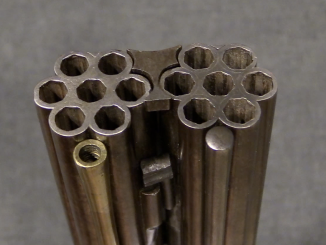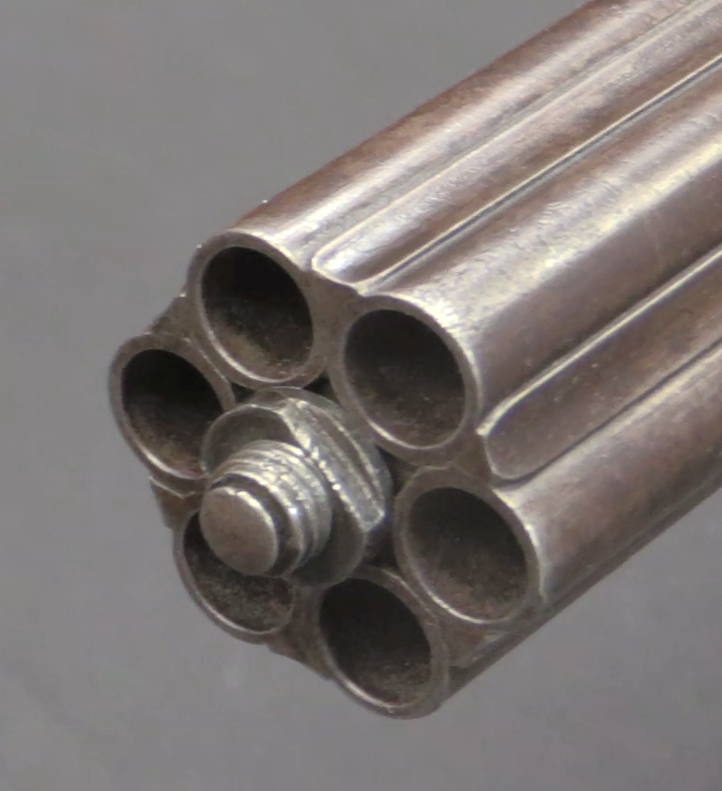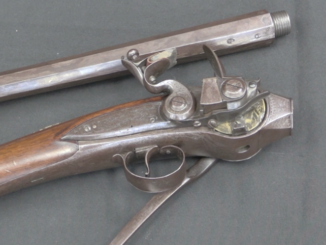In July of 1918, the British military formally adopted a Parker-Hale system of adapting .303-caliber arms to .22 rimfire for short range training. The system involved lining standard barrels with .22 caliber blanks that were machined with full size .303 chambers. Special cartridge inserts were used which had the external dimensions of .303 cartridges, but held .22LR cartridges inside. This allowed the weapon to use the same feeding system as it normally would, and to duplicate the handling and trigger mechanism of a standard .303 caliber gun wile only firing a small rimfire cartridge.
Parker-Hale built kits of this type for the Lee Enfield rifle, the Lewis LMG, and the Vickers HMG, and all were used by the British military. In the Lewis and Vickers, there was no accommodation made to actually cycle the guns; this sort of .22 practice drill was done by manually cycling the actions after each shot. Still, it was a good way to practice basic drill (loading, unloading, etc) as well as basic marksmanship without the noise of full power cartridges and without the need for a full-power-rated backstop.
The system for the Lee Enfield was replaced in 1920 (after only about 2 years of use) with the No2 MkIV* rifle, a dedicated .22 conversion of an SMLE. Parker-Hale kept the system in their commercial catalog into the 1930s, however.




It’s a more realistic system than an actual. 22rf rifle.
The idea was taken further in the 1980s with cases that contained a charge of Compressed air or CO2, and an airgun pellet.
It didn’t take long for the British bureaucracy to get scared and ban the peasantry from owning them.
I never got to handle one, let alone take one to bits.
I’m guessing that they were limited to within 12 foot pounds, for British consumption, compared to the 100 foot pounds plus energy of a .22 long rifle rimfire.
I used the .22 versions of the SMLE and No 4 and you don’t really lose much by having them single shot as opposed to magazine fed.
What you are learning on an indoor range is how to shoot and the ability to do more actual shooting rather than faffing about with adapters makes the trade-off of single shot worthwhile.
Practicing loading and unloading drills can be done quite adequately using inert drill rounds.
Of course the standard service rifle at that time was the C1 (FN FAL) rather than the No 4, but I think I’m pretty safe to say that the above would have still held true even when the No 4 (or SMLE) were the actual service rifles.
It would appear that the MoD (and DND) felt the same, as the Parker-Hale conversion kits were apparently phased out rather quickly.
Good presentation. I’ve always liked 22 conversations for military firearms and cartridge conversions in general and have a decent collection. The HK manufactured 22 conversion set made for the G3 I find the most fun. They are very well made and both reliable and very accurate.
Was that G3 conversion with blowback bolt, or manual repeater?
They are blowback. Replacement bolt carrier,chamber barrel insert and converted 20rd magazines. https://www.hkpro.com/attachments/af327cc9-1fc6-4ea7-993d-3bf84409a82d-jpeg.249628/
Thanks for reply. That Bolt is a substantial chunk of metal. The top part welded to it is likely hollow – my guess. Good looking kit overall.
“(…)I’ve always liked 22 conversations for military firearms(…)”
Such conversions are often interesting in answering question “how to convert center-fire fire-arm to rim-fire?”
You have good point here. Of course the “easiest” way is to introduce new breech block/ bolt with firing pin, but that is a costly solution. This is indeed a peculiar field of gun technology.
During my years of service we designed and prototyped all new 22LR dedicated rifle which was service rifle lookalike, including controls and outer magazine/ shell. It was destined primarily to cadets. Unfortunately it did not go into production because of liability concerns.
“In July of 1918, the British military formally adopted a Parker-Hale system of adapting .303-caliber arms to .22 rimfire for short range training.(…)”
Interestingly .22 rim-fire cartridge was initially known as Cartridge Aiming Tube Rimfire Mark I to British military
https://sites.google.com/site/britmilammo/-22-inch-rimfire
this implying usage in aiming tube similar to earlier Morris
https://sites.google.com/site/britmilammo/-23-inch-aiming-tube
used in .45 inch Martini Henry rifles.
What is the interchange hazard here?
Will a .303 cartridge fully chamber?
It certainly sounds like a .303 cartridge would chamber in the .22 conversions. A concern for collectors, but not for military use. Never let the .22 conversions leave the indoor range and you’re good. Militaries tend to tightly control ammunition during training, so the odds of someone sneaking a .303 cartridge into the indoor range would be pretty low, especially if they haven’t been exposed to the standard rifle yet.
Another safety concern with these, raised elsewhere, is the possibility of a loaded “container” discharging if dropped on it’s mouth onto a hard surface (due to the mass of the floating firing pin transfer rod). The risk, I suppose might be less about where the projectile might go, but that the “container” would fly in the opposite direction.
“(…)without the noise of full power cartridges and without the need for a full-power-rated backstop.(…)”
Considering when it was adopted (July 1918) it might be adopted in expectation of further lowering enlistment age or medical requirements.
Until 1916 service British forces were volunteer powered. Military Service Act 1916 caused all males aged between 19 and 41 and resided in Great Britain (excluding Ireland) and were unmarried or a widower on 2 November 1915 to become enlisted at 2 March 1916. Few months later lower age was dropped to 18. In April 1918 changes in law allowe soldiers aged 18 years and 6 months to be sent overseas as long as they had had six months training
http://www.longlongtrail.co.uk/soldiers/a-soldiers-life-1914-1918/enlisting-into-the-army/
Thus, would Great War rage on further lowering of standards. .22 rim-fire could be used for training for those which did not have yet physique for mastering .303 cartridge.
“(…)Lewis(…)”
Interestingly in training Royal Flying Corps air gunners Winchester 1903 installed to side of host weapon was used, see 3rd image from top
https://sites.google.com/site/britmilammo/-22-inch-automatic-rimfire
In Soviet Union Blüm machine gun was developed for training Maxim machine gunners, see image
https://en.wikipedia.org/wiki/Bl%C3%BCm_machine_gun
I bet it gets really spectacular when a real 303 round gets chambered and touched off ! Can anyone say 300 Blackout ?
Your posts are always interesting. Here in Australia back in the 1970’s, I was involved with army cadets as a teacher and range control officer. We had what was referred to as a “Morris Tube” conversion of the .303. Single shot, and we even had a 25 yard range at the bottom of the school oval. Those were the days!!
Morris Tubes do date back to 1880s https://www.rifleman.org.uk/Miniature_calibre_adapters_and_conversions.html
Thank you for the info
I wonder what the gas seLing was like?
There’s no sign of an o ring or any other sort of obturator on the outside of the adaptors.
Can we assume that they leaked lots of gas back into the faces of the fires?
You need to check out the U.S. M3 and M4 .22 conversions for the Browning M1917a1 and M1919a4 machine guns. The use of a floating chamber (incorporation of which into the design is attributed to “Carbine” Williams) allows these machine guns to operate in full automatic while shooting .22s.
There’s a patent that Ian posted a few years back
That shows a floating chamber,
I can’t remember whether it was from before or just after Williams was born.
While I never encountered any .22 training weapons in the military, I would have appreciated a single shot option such as this for T&E familiarization. I can’t help but wonder if the Vickers adapter did just that in an indoor range setting.
“(…)never encountered any .22 training weapons in the military(…)”
This might differ depending on country or even branch. For example NVA used even .22 rim-fire AKM look-alike which was selective-fire and used externally similar magazines, it was called KK-MPi 69 https://modernfirearms.net/en/submachine-guns/kk-mpi-69-2/
I came across one of these complete kits recently. Does anyone happen to know the value of a complete kit?